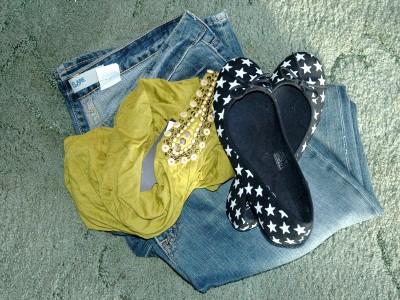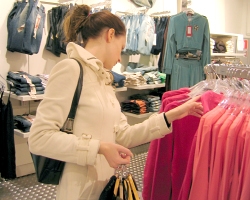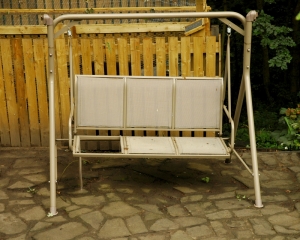Stuff hangovers and aspirational buying
 In this, the Decluttering season, I’ve been thinking a lot about stuff and about how it comes into our lives. My intention was to write this post about the idea of a “stuff hangover” but after reading an article on Get Rich Slowly, I think it’s about more than that.
In this, the Decluttering season, I’ve been thinking a lot about stuff and about how it comes into our lives. My intention was to write this post about the idea of a “stuff hangover” but after reading an article on Get Rich Slowly, I think it’s about more than that.
I suffer from a stuff hangover in several different areas – I’ve changed who I am and what I do but I’ve got stuff hanging over from previous versions of myself. For example, when I moved into our last house in 2000, I was straight out of university and I brought over all my uni notes, books and accoutrement. We brought a large proportion of those books and notes over here when we moved too even though I have long ago abandoned my post-grad plans in that area of study. Another thing: about five years ago, John wrote a comic strip that was quite popular in its incredibly nerdy niche and we sold t-shirts, stickers and badges based on the “characters” and in-jokes. The comic eventually wound up and when shirts sales reduced to a tickle, we took the shop offline too – but we still have a couple of boxes of stock leftover. Together the books/notes and t-shirts take up a fair amount of our storage space and because I see it regularly, I know I need to be brutal and get rid of it.
But there are smaller things that I’m blind to – the twenty pairs of trainer socks I cleared out from my sock drawer the other week were a smaller example, as are the various bits of jewellery I decluttered during last week’s mini-challenge. The jewellery hardly took up any space at all but it was there – in a jewellery box I didn’t use except to keep that unused jewellery in. It all adds up.
So that’s stuff from past-louisa still cluttering up life for present-louisa – the Get Rich Slowly article I mentioned at the start is, in part, about accumulating clutter/wasting money on things present-louisa wants to buy in order to be the perfect possible version of future-louisa: aspirational buying. The article (and comments) talk about things like when people buying exercise equipment because it’ll “force” them to keep fit, or buying the perfect dress or winter coat just because you like them, even though you never go anywhere nice or cold. The main focus of the article is about “buy for every day not special occasions“, which is something I’ve thought about before in terms of not getting use out of things because they’re saved “for best” but in this circumstance, it’s also about choosing a home or car that suits your every day needs not the once a year family get together, or camping trip (in both cases, it’s usually cheaper to pick something smaller and rent a hall/camper van when you need it, rather than having to pay for the extra cost, insurance etc).
Read MoreBad buys: nearly all the clothes I’ve ever bought off eBay
Another in my occasional series of laments about bad buys I’ve made.
I love eBay. We call our house “the house that eBay built” because we bought so much stuff – appliances, furniture, accessories – off eBay in the first few months after we moved in. I use it as a find-anything bazaar and a virtual charity shop. But I’ve had failure after failure when it comes to buying clothes off there.
From seeing just one or two deliberately flattering pictures of the item, I create a best-possible-case 3D animation in my head: me wearing the item, it fitting perfectly and looking great. Surely that’s worth £1.50 plus p&p! Unless it’s something that really excites me, I won’t get caught up in eBay drama or bidding wars – my bids stay charity-shop-price low and if I get outbid then nevermind. But often enough, I do win and my “fits perfectly, looks great” fantasy continues for a few days until it arrives.
It’s happened with the weirdly (deliberately) patchwork leather jacket, the far too boxy polyester Hawaiian shirt, the strappy tops which were apparently made for someone with a half-sized torso, the “I could fit three of us in there and we’d all look like weird scientists” dressing gown, the shoes in the picture are nice but super narrow (and clearly very cheap quality to start with)… I could go on and on. None of these items have cost more than a few quid all in, but those few quids do add up.
Read MoreHow can you tell when something is good quality?
This is another cross-post between The Really Good Life and my recycling blog, How Can I Recycle This?
The first stage of the recycling triangle is Reduce – reduce the amount of things you buy/use and buy items that’ll last and can be repaired rather than ones that need replacing frequently. A key rule of frugal living is similar: don’t pay twice for something – a more expensive quality item might last two-three-four-times longer than the cheaper alternative.
But how can you tell when something is good quality – that it’s worth the extra money and it’ll last?
Back in the day, it used to be all about price – better quality items made with better quality materials cost more. But the rise of all powerful brands put an end to that. Now poor quality items made from poor quality materials command a huge price if they’ve got the right logo on them. And once respected brands have lowered their quality, or spun off lower quality ranges, without dropping their prices, hoping we won’t notice the difference. I’ve used a picture of clothes because the fashion mark-up is really obvious with them, but it’s an issue across the board: clothes, food, homewares, tools, electronics, cars, cleaning products…
Whenever we’re making major purchases, we look up reviews online/tap the expertise of friends on Twitter to ask their opinions but people have a habit of suggesting the thing they have/use rather than the best thing: partly because it’s often all they have experience of and partly because the more people who join them helps justify it’s their decision. Most people I know have their own area of expertise – for example, I know a lot of geeks and they know from painful experience what computers should be bought and what should be avoided like the plague – but outside their area of knowledge, they’re at a bit of a loss.
So how do you tell what’s good and what isn’t? What cues tell you when something is worth the extra money? And when it definitely isn’t?
Do you have a particular area of expertise? If so, tell us all about it!
Read MoreBad Buys: the garden swing
This will be an occasional series of posts documenting my worst buys over the years and why they were a mistake. I hope it’ll help me – and other people – learn from my mistakes.
When we moved into our new house last autumn, there was an old garden swing cemented into the patio in the garden. My mum and dad had a similar swing for a few years when I was a kid – a white metal tube frame with big puffy plastic-coated cushions – and according to our photo albums, our family lived on it in the summer. John wasn’t keen on the swing here though because it looked rickety, somewhat knackered and in white, stood out against the natural colours of our garden – but I thought we might as well use it since it was there. Maybe play up the retro – brighten up the white & cover the dated floral cushions with a red polka dot design. It was put on the list for “things to do over the summer” and forgotten about.
Then a (used) swing popped up on my “around here and cheap” eBay search. In a mushroom-y beige colour, it wouldn’t stand out so much, it looked more solid and best of all, it was more practical because the seats were the plastic mesh, meaning we could use it without having to climb two flights of stairs to get the cushions. It was £30 and only a short drive away. We ‘bought it then’. At no point did we ask ourselves whether we actually wanted a swing – we were just hell-bent on replacing the old one with a better one than the one we had.
Read More





